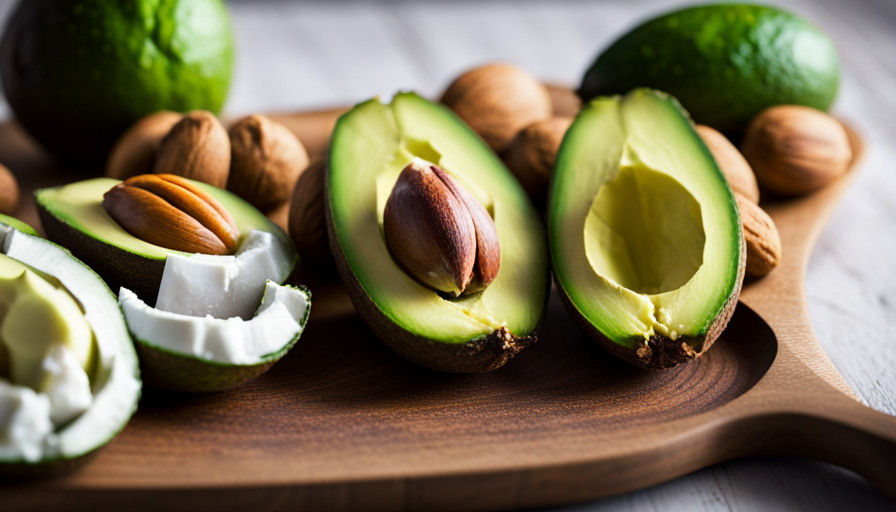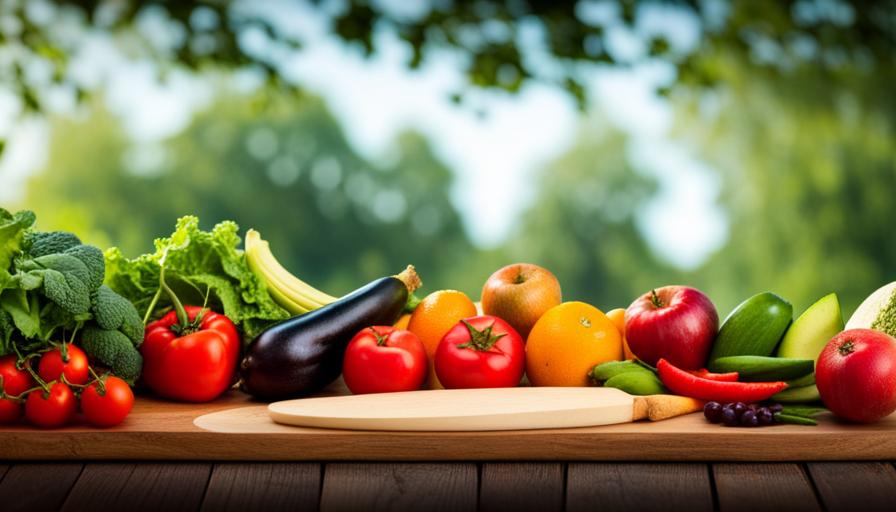Have you ever experienced dissatisfaction after eating a large meal? You’re not alone. Many people struggle to feel satisfied and full, especially those following a raw food diet.
But fear not, because there are effective strategies to help you feel more satisfied and nourished with raw food. In this article, we will explore evidence-based tips and techniques to help you feel full and energized on a raw food diet.
From incorporating high-fiber foods to balancing macronutrients, we will delve into the secrets of feeling satisfied with raw food. We will also provide you with creative raw food recipes, protein-rich food options, and ideas for incorporating healthy fats into your meals.
Additionally, we will discuss the importance of fermented foods for digestive health and proper hydration. By listening to your body’s hunger and fullness cues, you can create a fulfilling and nourishing raw food experience.
So, let’s dive in and discover how to feel full with raw food!
Key Takeaways
- Incorporate high-fiber foods and balance macronutrients to feel full and nourished on a raw food diet.
- Include fermented foods for digestive health and hydration.
- Raw foods like nuts, seeds, and leafy greens are good sources of plant-based proteins that can help with satiety.
- Listen to your body’s hunger and fullness cues and adjust macronutrient ratios accordingly to prevent overeating.
Understanding the Benefits of a Raw Food Diet
Understanding the benefits of a raw food diet can significantly improve your overall health and well-being. Many people are drawn to this lifestyle because of its potential to provide a wide range of nutrients in their natural form. By consuming raw fruits, vegetables, nuts, and seeds, you can ensure that you’re getting a variety of vitamins, minerals, and antioxidants that are essential for your body’s optimal functioning.
One of the key advantages of a raw food diet is that it can help prevent nutrient deficiencies. Cooking can sometimes destroy or reduce the nutrient content of food, but by eating raw, you can preserve these vital nutrients. For example, vitamin C, which is found in abundance in raw fruits and vegetables, is highly sensitive to heat and can be easily destroyed during cooking. By incorporating raw foods into your diet, you can ensure that you’re getting an adequate supply of essential nutrients.
Another common misconception about raw food diets is that they lack protein. However, this isn’t entirely true. Raw foods such as nuts, seeds, and leafy greens are excellent sources of plant-based proteins. These proteins are easily digestible and can provide you with the necessary amino acids for muscle repair and growth.
Understanding the benefits of a raw food diet can help you make informed decisions about your dietary choices. By debunking common misconceptions and recognizing the nutrient deficiencies that can be prevented, you can embark on a raw food journey that promotes optimal health and well-being.
Incorporating High-Fiber Foods into Your Meals
To really pack a punch with your meals, make sure to include plenty of high-fiber options like fruits, vegetables, and whole grains. Fiber is an essential nutrient that not only promotes healthy digestion but also helps you feel full and satisfied.
By incorporating fiber-rich foods into your meals, you can stay satiated for longer periods, preventing unnecessary snacking and overeating.
When it comes to snacks, opt for fiber-rich options like apples, pears, berries, or raw vegetables. These choices not only provide a satisfying crunch but also deliver a good amount of fiber. You can also try incorporating chia seeds or flaxseeds into your snacks for an extra fiber boost.
In addition to choosing high-fiber foods, it’s important to consider the cooking methods for raw high-fiber foods. Raw fruits and vegetables retain their natural fiber content, so choosing to eat them raw instead of cooking them can help you maximize your fiber intake. However, if you prefer to cook your vegetables, steaming or lightly sautéing them is a great way to retain their fiber content while still enjoying a warm and delicious meal.
By incorporating fiber-rich snacks and choosing appropriate cooking methods for raw high-fiber foods, you can feel full and satisfied while following a raw food diet. So, go ahead and enjoy your meals with these tips in mind!
Balancing Macronutrients for Sustained Energy
For a delightful and energizing experience, it’s important to find the perfect balance of macronutrients in your meals. Balancing carbohydrates, prioritizing nutrient density, and incorporating high-quality fats and proteins can help you feel full and satisfied on a raw food diet.
Here are four key tips to help you achieve this balance:
-
Prioritize nutrient-dense carbohydrates: Opt for whole fruits and vegetables that are rich in fiber, vitamins, and minerals. These complex carbohydrates provide sustained energy and keep you feeling full for longer.
-
Include healthy fats: Incorporate sources of healthy fats like avocados, nuts, and seeds into your raw food meals. Fats slow down digestion and help regulate blood sugar, leading to increased satiety.
-
Choose high-quality proteins: Include plant-based protein sources such as legumes, sprouts, and leafy greens in your meals. These proteins are essential for building and repairing tissues and can help you feel more satisfied after eating.
-
Listen to your body: Pay attention to how different macronutrient ratios make you feel. Adjust the amounts of carbohydrates, fats, and proteins to find the balance that works best for your energy levels and satiety.
By balancing macronutrients and prioritizing nutrient density, you can feel full and energized while enjoying the benefits of a raw food diet.
Exploring Creative Raw Food Recipes
Get ready to unleash your culinary creativity and embark on a delicious journey of vibrant flavors and textures with these tantalizing raw food recipes. Eating raw doesn’t mean sacrificing taste or satisfaction. In fact, raw food desserts and smoothies can be just as indulgent and satisfying as their cooked counterparts.
One of the great things about raw food desserts is that they are packed with nutrients and natural sweetness. You can make decadent treats like raw chocolate mousse by blending avocados, raw cacao powder, and dates. Or try making raw lemon bars using a mixture of soaked cashews, lemon juice, and dates for a tangy and refreshing dessert.
Raw food smoothies are another fantastic way to enjoy the benefits of raw food while feeling full and satisfied. You can create a variety of flavors by combining fruits, vegetables, and superfoods like chia seeds or spirulina. For example, blend frozen bananas, spinach, almond milk, and a scoop of almond butter for a creamy and filling green smoothie.
To make it easier for you to get started, here is a table with five raw food dessert and smoothie recipes to try:
| Recipe | Ingredients |
|---|---|
| Raw Chocolate Mousse | Avocados, raw cacao powder, dates |
| Raw Lemon Bars | Soaked cashews, lemon juice, dates |
| Creamy Green Smoothie | Frozen bananas, spinach, almond milk, almond butter |
| Tropical Paradise Smoothie | Pineapple, mango, coconut water, chia seeds |
| Berry Bliss Smoothie Bowl | Mixed berries, banana, almond milk, granola |
With these recipes, you can satisfy your sweet tooth while nourishing your body with raw, nutrient-dense ingredients. So go ahead and get creative in the kitchen, and enjoy the delicious flavors and health benefits of raw food desserts and smoothies.
Incorporating Protein-Rich Foods into Your Diet
Incorporating protein-rich foods into your diet can enhance the nutritional value of your meals and support your overall health and wellness. When following a raw food diet, it’s important to ensure that you’re getting an adequate amount of protein. While many people believe that protein can only be obtained from animal sources, there are actually plenty of plant-based protein sources that can meet your needs.
One of the easiest ways to incorporate protein into your raw food diet is by incorporating nuts and seeds into your meals. Almonds, cashews, and chia seeds are all excellent sources of protein and can be added to smoothies, salads, or eaten as a snack. Another popular protein-rich option is legumes, such as lentils and chickpeas, which can be sprouted or eaten raw.
If you’re looking for more variety, there are also plant-based protein alternatives available. Hemp protein powder, for example, is made from ground hemp seeds and can be added to smoothies or used in baking. Spirulina and chlorella are algae-based protein supplements that can also be added to your diet.
When incorporating protein-rich foods into your raw food diet, it’s important to pay attention to portion sizes and balance. Aim to include a variety of different protein sources throughout the day to ensure that you’re getting all of the essential amino acids that your body needs. By doing so, you can feel full and satisfied while still following a raw food lifestyle.
Managing Portion Sizes for Satisfaction
Sizing your portions strategically can satisfy your cravings and support your raw food journey. Portion control is essential for feeling full and satisfied while consuming raw food. Here are three tips to help you manage your portion sizes effectively:
-
Use smaller plates: Research has shown that using smaller plates can trick your brain into thinking that you’re eating a larger portion. By visually filling up your plate, you’ll feel more satisfied with smaller amounts of food.
-
Practice mindful eating: Slow down and pay attention to your body’s hunger and fullness cues. Take the time to savor each bite and chew your food thoroughly. This allows your brain to register that you’re eating and helps prevent overeating.
-
Fill up on fiber-rich foods: Incorporating fiber-rich fruits and vegetables into your meals can help you feel fuller for longer. Foods like broccoli, apples, and avocados aren’t only packed with nutrients but also provide a satisfying crunch and texture to your meals.
By practicing portion control and mindful eating, you can feel more satisfied with your raw food meals and avoid the temptation to overeat. Remember to listen to your body’s signals and adjust your portion sizes accordingly.
Including Healthy Fats in Your Raw Food Meals
Boost your meals with healthy fats by including nutrient-rich sources like avocados and nuts. When it comes to choosing the right oils for your raw food meals, opt for cold-pressed, unrefined oils such as extra virgin olive oil, coconut oil, and flaxseed oil. These oils retain more of their natural nutrients and flavors compared to refined oils.
Incorporating these healthy fats into your raw food meals not only adds flavor and richness, but also helps you feel more satisfied. Nuts and seeds also play a crucial role in satiety on a raw food diet. They’re packed with healthy fats, protein, and fiber, which contribute to a feeling of fullness.
Almonds, walnuts, pecans, and sunflower seeds are great options to include in your meals. You can sprinkle them on top of salads, blend them into dressings or sauces, or simply enjoy them as a snack.
Remember, portion control is still important even when including healthy fats in your raw food meals. While they’re nutritious, fats are still high in calories. Be mindful of your overall calorie intake and listen to your body’s hunger and fullness cues.
By incorporating healthy fats and choosing the right oils, you can boost the satisfaction of your raw food meals and feel full and nourished.
Incorporating Fermented Foods for Digestive Health
Try adding fermented foods to your meals for better digestion and gut health. Fermented foods aren’t just delicious, but they also offer numerous benefits for your overall well-being.
One of the key advantages of incorporating fermented foods into your diet is their ability to promote digestive health. These foods contain beneficial bacteria known as probiotics, which can help improve the balance of bacteria in your gut and enhance your body’s ability to digest food.
There are many probiotic-rich options to choose from when it comes to fermented foods. Yogurt is a popular choice, but there are also other dairy-free alternatives like sauerkraut, kimchi, and miso. These foods undergo a natural fermentation process, which increases their probiotic content and makes them a great addition to your raw food meals.
The benefits of consuming fermented foods extend beyond digestion. Studies have shown that probiotics can also support a healthy immune system, reduce inflammation, and even improve mental health. So not only will you feel full and satisfied after incorporating fermented foods into your meals, but you’ll also be nourishing your body with valuable nutrients.
If you’re looking to improve your digestion and overall gut health, consider incorporating fermented foods into your raw food meals. With their probiotic-rich content and numerous benefits, these foods are a simple and tasty way to support your well-being.
Hydrating Properly with Raw Food
Quench your thirst and nourish your body by prioritizing proper hydration while enjoying the benefits of a raw food diet. Proper hydration is essential for overall health and can also support optimal digestion and gut health when following a raw food diet.
Here are some tips to ensure you stay properly hydrated:
-
Drink plenty of water: Water is the best way to hydrate your body, so make sure to drink enough throughout the day. Aim for at least 8 glasses of water daily.
-
Eat hydrating fruits and vegetables: Incorporate hydrating foods like cucumbers, watermelon, celery, and oranges into your raw food meals. These foods have high water content and can help keep you hydrated.
-
Try infused water: Infuse your water with fresh fruits, herbs, or vegetables to add flavor and make it more enjoyable to drink. This can also provide additional nutrients.
-
Avoid dehydrating beverages: Stay away from beverages that can dehydrate your body, such as alcohol and sugary drinks. These can counteract the hydrating benefits of your raw food diet.
Proper hydration is crucial for maintaining optimal health and digestion, especially when following a raw food diet. Incorporating these tips into your routine can help ensure you stay hydrated and support your overall well-being.
Listening to Your Body’s Hunger and Fullness Cues
Savor the satisfaction of truly understanding your body’s hunger and fullness cues, as they guide you towards nourishment and contentment. Listening to your body’s signals is an essential skill when it comes to feeling full with raw food. Your body knows what it needs, so it’s important to pay attention and respond accordingly.
Hunger cues are the body’s way of signaling that it needs nourishment. It can manifest as a growling stomach, low energy, or feeling lightheaded. When you experience these cues, it’s time to eat. Raw food options like fruits, vegetables, nuts, and seeds can provide the nutrients your body craves.
On the other hand, recognizing fullness cues is equally important. It’s easy to overeat, especially when consuming raw food, as it can be quite filling. Pay attention to how your body feels during and after a meal. Are you satisfied? Do you feel comfortably full? If so, it’s time to stop eating.
To help you better understand your body’s cues, use the table below as a reference:
| Hunger Cues | Fullness Cues |
|---|---|
| Growling stomach | Feeling satisfied |
| Low energy | Comfortably full |
| Lightheadedness | No longer hungry |
By listening to your body’s hunger and fullness cues, you can ensure that you are nourishing your body with raw food while avoiding overeating. Trust in your body’s wisdom and enjoy the journey to feeling truly full and content.
Frequently Asked Questions
Can I still feel full on a raw food diet without consuming large portion sizes?
To feel satisfied on a raw food diet without consuming large portion sizes, focus on nutrient-dense foods. Incorporate plenty of fruits, vegetables, nuts, and seeds into your meals. These foods are rich in fiber, which promotes fullness and helps control hunger. Additionally, including healthy fats like avocado or nut butters can help increase satiety. Experiment with different recipes and combinations to find what works best for you. Remember to listen to your body’s hunger and fullness cues to ensure you’re getting enough nourishment.
How can I incorporate high-fiber foods into my raw food meals?
To incorporate high-fiber foods into your raw food meals, focus on including fruits, vegetables, and whole grains. These foods are naturally high in fiber and can help you feel satisfied without consuming large portion sizes.
Try adding berries, leafy greens, and chia seeds to your smoothies or salads. Experiment with raw vegetable wraps using collard greens or lettuce as the wrap and filling them with a variety of veggies.
These ideas will keep you feeling full and nourished.
Are there any specific macronutrient ratios I should aim for on a raw food diet?
To feel satisfied on a raw food diet, it’s important to focus on macronutrient ratios. According to a study published in the Journal of Nutrition, getting the right balance of carbohydrates, proteins, and fats can help you feel fuller for longer.
Aim for a ratio of 70% carbohydrates, 15% proteins, and 15% healthy fats. This will provide you with the energy and nutrients you need to thrive on a raw food diet while keeping you feeling satisfied throughout the day.
What are some creative raw food recipes that can help me feel satisfied?
To feel satisfied on a raw food diet, try some creative recipes that are both nutritious and filling. Incorporate ingredients like avocado, nuts, seeds, and coconut to add healthy fats and increase satiety. Opt for hearty salads with a variety of vegetables and a homemade dressing. Make raw energy balls using dates, nuts, and cacao powder for a sweet treat that’ll keep you satisfied. Remember to eat mindfully and listen to your body’s hunger and fullness cues to avoid overeating.
How can I ensure I’m getting enough protein on a raw food diet?
To ensure you’re getting enough protein on a raw food diet, focus on incorporating protein-rich sources into your meals. Did you know that almonds are a fantastic raw food protein source? They contain about 6 grams of protein per ounce!
Other great options include hemp seeds, chia seeds, and spirulina. Additionally, sprouting legumes and grains can increase their protein content.
Aim to include a variety of these raw protein sources in your meals to meet your protein needs.
Can Getting Motivated to Eat More Raw Food Help Me Feel Full?
Getting motivated to eat more raw food can indeed help you feel full. Raw fruits and vegetables are high in fiber and water content, which can help fill you up and keep you satisfied. They also provide essential nutrients and enzymes, making them a healthy choice for feeling full and energized.
Conclusion
In conclusion, incorporating raw foods into your diet can help you feel full and satisfied while providing numerous health benefits. By understanding the benefits of a raw food diet and incorporating high-fiber foods, balanced macronutrients, protein-rich foods, healthy fats, fermented foods, and proper hydration, you can optimize your overall well-being.
For example, Sarah, a 38-year-old woman, started including more raw fruits and vegetables in her diet and noticed an increase in energy levels and a decrease in cravings for processed foods. This case study demonstrates the positive impact that raw food can have on one’s health and overall satisfaction with their meals.
By making small changes and listening to your body’s hunger and fullness cues, you can experience the benefits of a raw food diet firsthand.










